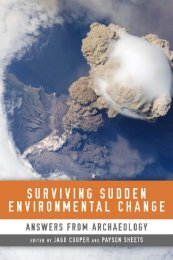Utatlan: The Constituted Community of the K'iche Maya of Q'umarkaj
Utatlan: The Constituted Community of the K'iche Maya of Q'umarkaj
Utatlan: The Constituted Community of the K'iche Maya of Q'umarkaj
Create successful ePaper yourself
Turn your PDF publications into a flip-book with our unique Google optimized e-Paper software.
<strong>The</strong> Greater Utatlán Project<br />
situations change, in response ei<strong>the</strong>r to internal events or to outside circumstances<br />
(Smith 2003: 4–5).<br />
<strong>Community</strong> as a Framework for Conceptualizing <strong>the</strong> Archaeological Record<br />
Weeks (1980) excavated at <strong>the</strong> K’iche’ center <strong>of</strong> Chisalin, although he confined<br />
his work to <strong>the</strong> epicenter <strong>of</strong> that site and its elite structures. He did, however,<br />
attempt to describe <strong>the</strong> social integration <strong>of</strong> <strong>the</strong> site, using a functional assessment<br />
<strong>of</strong> excavated mound groups based on architectural and artifact variations (1980:<br />
11–139). He assumed Chisalin to be an “integrated entity” and that <strong>the</strong> spatial<br />
organization <strong>of</strong> <strong>the</strong> site should “be related to <strong>the</strong> organization <strong>of</strong> <strong>the</strong> social community<br />
that occupied it” (1980: 175). On <strong>the</strong> basis <strong>of</strong> <strong>the</strong> archaeological remains,<br />
Weeks attempted to define <strong>the</strong> social space <strong>of</strong> Chisalin using concepts <strong>of</strong> connectivity<br />
and accessibility (1980: 196–207).<br />
Brown (1987) commented: “<strong>Maya</strong>nists have developed an interesting assumption:<br />
mounds clustered toge<strong>the</strong>r produce a social group. People clustered toge<strong>the</strong>r<br />
may produce a social group, but mounds never do” (Brown 1987: 196; italics in<br />
original). He questioned Weeks’s assumption that patterns <strong>of</strong> access, which reflect<br />
in turn patterns <strong>of</strong> interaction, would <strong>the</strong>reby reflect interaction <strong>of</strong> groups <strong>of</strong> individuals.<br />
Archaeology is primarily a study <strong>of</strong> human behavior and intends to make<br />
interpretations about human behavior based on <strong>the</strong> archaeological record. This may<br />
be represented by groups or mounds or by households, however defined, <strong>the</strong>ir artifact<br />
inventory, and <strong>the</strong>ir spatial arrangement. Brown refers to a “<strong>the</strong>oretical/methodological<br />
trap,” but <strong>the</strong> criticism itself is a semantic trap. It is appropriate that we<br />
conceptualize <strong>the</strong> human behavior represented in <strong>the</strong> archaeological record while<br />
recognizing that it was people who created and used <strong>the</strong> artifacts or who were <strong>the</strong><br />
socially interacting groups. At <strong>the</strong> same time it is also appropriate to limit our statements<br />
to what is, in fact, observable in <strong>the</strong> record. This was clearly expressed by<br />
Weeks regarding interpretation <strong>of</strong> mounds; that is, <strong>the</strong> mounds do not form social<br />
groups. Concerning residential structures, Weeks states, “This tendency for spatial<br />
segregation suggests that <strong>the</strong>se buildings did not serve <strong>the</strong> needs <strong>of</strong> <strong>the</strong> general population”<br />
(1980: 212).<br />
At Copán, Honduras, Fash and colleagues used a conjunctive approach to <strong>the</strong><br />
archaeological excavations (Canuto 2003; Canuto and Fash 2004), in which “<strong>the</strong><br />
larger research enterprise was designed to balance separate efforts targeting different<br />
scales <strong>of</strong> analysis at <strong>the</strong> same Classic period polity” (Canuto and Fash 2004: 53).<br />
Part <strong>of</strong> this process involved <strong>the</strong> de-emphasis on spatial or physical characteristics<br />
and sought to establish a constituted community that represented not a physical<br />
place but ra<strong>the</strong>r an idea about that place (2004: 65). One component <strong>of</strong> <strong>the</strong> Copán<br />
studies was household analysis (Freter 2004; Johnston and Gonlin 1998). Johnston<br />
23





